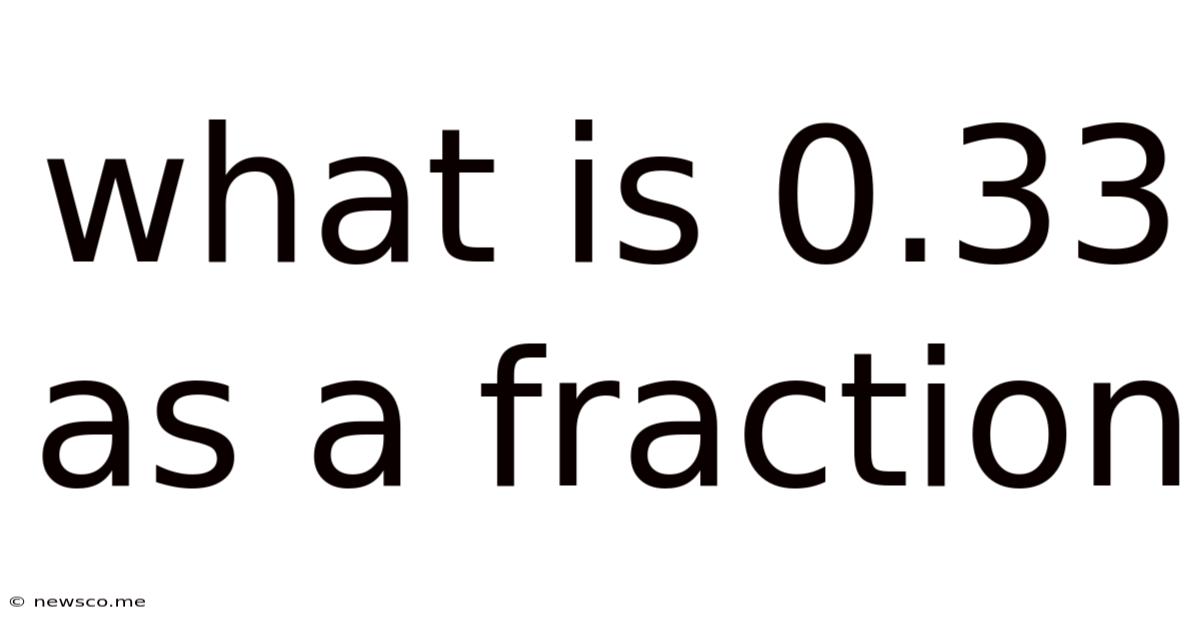What Is 0.33 As A Fraction
News Co
Apr 28, 2025 · 4 min read

Table of Contents
What is 0.33 as a Fraction? A Comprehensive Guide
Decimal numbers, like 0.33, are often encountered in everyday life, from calculating prices to measuring quantities. Understanding how to convert decimals to fractions is a fundamental skill with applications in various fields, including mathematics, science, and engineering. This comprehensive guide will delve into the process of converting 0.33 to its fractional equivalent, exploring different methods and providing a deeper understanding of the underlying concepts.
Understanding Decimal and Fraction Representation
Before we tackle the conversion, let's briefly revisit the concepts of decimals and fractions.
Decimals represent numbers as a sum of powers of ten. Each digit to the right of the decimal point represents a fraction with a denominator that is a power of ten. For example, 0.33 can be understood as 3/10 + 3/100.
Fractions, on the other hand, represent a part of a whole. They are composed of a numerator (the top number) and a denominator (the bottom number). The numerator represents the number of parts you have, and the denominator represents the total number of parts the whole is divided into.
Converting 0.33 to a Fraction: The Simple Method
The most straightforward way to convert 0.33 to a fraction is to read the decimal aloud. 0.33 is read as "thirty-three hundredths." This directly translates to the fraction 33/100.
This fraction is already in its simplest form because 33 and 100 share no common factors other than 1. Therefore, 33/100 is the final answer.
A Deeper Dive: Understanding Fraction Simplification
While 33/100 is the correct answer, understanding fraction simplification is crucial for representing fractions in their most concise form. Simplification involves dividing both the numerator and the denominator by their greatest common divisor (GCD). The GCD is the largest number that divides both the numerator and the denominator without leaving a remainder.
In the case of 33/100, the GCD of 33 and 100 is 1. This means the fraction is already in its simplest form, as dividing both the numerator and denominator by 1 doesn't change the value.
Let's consider another example to illustrate the process: Suppose we want to simplify the fraction 12/18.
- Find the GCD: The GCD of 12 and 18 is 6.
- Divide both numerator and denominator by the GCD: 12 ÷ 6 = 2 and 18 ÷ 6 = 3.
- Simplified Fraction: The simplified fraction is 2/3.
Converting Repeating Decimals to Fractions: A More Complex Scenario
While 0.33 is a terminating decimal (it ends), many decimals are repeating decimals, meaning they have a sequence of digits that repeats infinitely. Converting repeating decimals to fractions requires a slightly different approach. Let's explore this with an example: converting 0.333... (where the 3s repeat infinitely) to a fraction.
-
Represent the Repeating Decimal: Let x = 0.333...
-
Multiply by 10: Multiply both sides of the equation by 10 (or a multiple of 10 depending on the repeating pattern): 10x = 3.333...
-
Subtract the Original Equation: Subtract the original equation (x = 0.333...) from the equation obtained in step 2: 10x - x = 3.333... - 0.333... 9x = 3
-
Solve for x: Divide both sides by 9: x = 3/9
-
Simplify the Fraction: The GCD of 3 and 9 is 3. Dividing both numerator and denominator by 3, we get: x = 1/3
Therefore, 0.333... (a repeating decimal) is equivalent to the fraction 1/3. Note that 0.33 (a terminating decimal) is an approximation of 1/3.
Practical Applications of Decimal-to-Fraction Conversions
The ability to convert decimals to fractions is not just a theoretical exercise; it has numerous practical applications:
-
Cooking and Baking: Recipes often require precise measurements. Converting decimal measurements to fractions ensures accuracy. For example, a recipe might call for 0.75 cups of sugar, which is equivalent to ¾ cups.
-
Construction and Engineering: Precise calculations are vital in these fields. Converting decimal measurements to fractions allows for more accurate calculations and measurements, ensuring the structural integrity of buildings and other structures.
-
Finance: Calculating interest rates, discounts, and profit margins often involves working with both decimals and fractions. Converting between them allows for a more thorough understanding of financial situations.
-
Data Analysis: In statistics and data analysis, understanding how to work with fractions is crucial for interpreting results and drawing meaningful conclusions. Many statistical calculations involve fractions and ratios.
Advanced Techniques and Considerations
For more complex decimal numbers, particularly those with longer repeating patterns, more advanced techniques like using geometric series might be necessary. These techniques are typically taught at a higher mathematical level.
Conclusion: Mastering Decimal-to-Fraction Conversions
Converting 0.33 to a fraction is a straightforward process, resulting in the simple fraction 33/100. However, understanding the underlying principles of decimals, fractions, and simplification is crucial for tackling more complex scenarios, such as converting repeating decimals. The ability to perform these conversions is a valuable skill with broad applications across numerous fields, emphasizing the importance of mastering this fundamental mathematical concept. By understanding these methods, you'll be well-equipped to handle decimal-to-fraction conversions with confidence and accuracy. Remember, practice makes perfect! Work through various examples to solidify your understanding and build your skills.
Latest Posts
Related Post
Thank you for visiting our website which covers about What Is 0.33 As A Fraction . We hope the information provided has been useful to you. Feel free to contact us if you have any questions or need further assistance. See you next time and don't miss to bookmark.